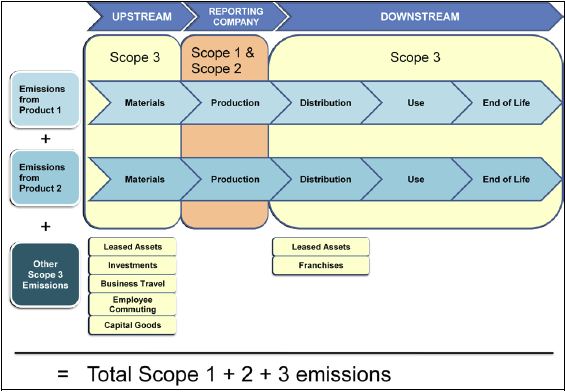|
Value Chain (Scope 3 GHG Emissions) Analysis
Many businesses are by now familiar with reporting their scope 1 and scope 2 GHG
emissions from sources they own/control and from purchased energy respectively.
Scope 3 emissions are generally much larger and far more significant. We now
have the analysis technology,
data and
industry standards to provide a
comprehensive value chain analysis including a full accounting of scope 3
emissions.
Why Scope 3 Emissions?
The
GHG Protocol
states: Scope 3 emissions
are often the largest source of emissions for companies and therefore often
represent the largest opportunity for
greenhouse gas reductions.

Scope 3
emissions include upstream activities such as the production of goods and
services purchased by the company, as well as downstream activities such as
consumer use and disposal of products sold by the company. A comprehensive
approach to corporate GHG emissions measurement, management and reporting –
incorporating scope 1, scope 2 and scope 3 emissions – enables companies to
focus on the greatest opportunities to reduce emissions within the full value
chain, leading to more sustainable decisions about the products companies
produce, buy and sell.
A scope 3 emissions inventory can reveal significant opportunities for improving
resource efficiency
– for more insights on this, see our
recent article on
how scope 3 inventories can be part of an overdue solution for advancing the
efficiency of material use.
Our Solution
Our value chain analysis service leverages
MetaFlowScope™ (our resource
flow analysis software) and the associated LCI database to deliver an
accessible and highly cost-effective solution. The analysis will be based on a
life-cycle perspective of your entire operation, including all relevant upstream
and downstream activities:
-
Extraction, production, processing, packaging and transport of raw materials and ingredients
(our LCI database provides high-quality life cycle data on more than 1500
products and processes -
including extensive coverage of food ingredients, food processing, packaging
materials, materials/processes used in manufacturing and construction, transport
and refrigerated storage)
-
Manufacturing, processing or cooking at your facilities -
including all energy use, water use and waste disposal.
-
Delivery of products through distribution and retail stages to consumers or
other businesses.
-
Use and disposal of products and packaging by end users.
We will not only
provide a detailed accounting of your
scope 3 emissions
(along with scope 1 and scope 2 emissions) and assist with proper reporting of
these emissions, but also
help you discover hotspots and inefficiencies in your operation which
represent opportunities for both emissions reduction and cost savings.
(See our combined software and service offerings.)
© Copyright 2007-2011 by CleanMetrics Corp. All rights reserved.
CleanMetrics, CargoScope, CarbonScope, BuildingScope, CarbonScopeData,
FoodCarbonScope, Deep Carbon Footprinting, and MetaFlowScope are trademarks of CleanMetrics Corp. |
|
